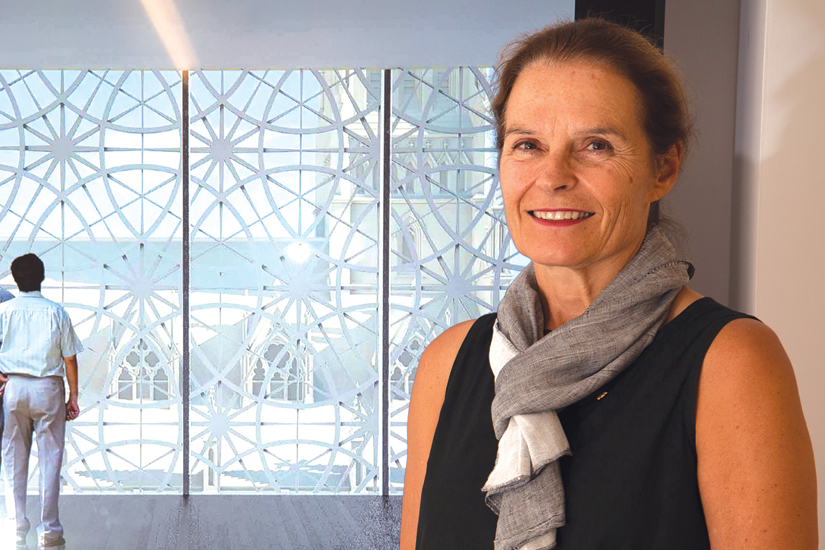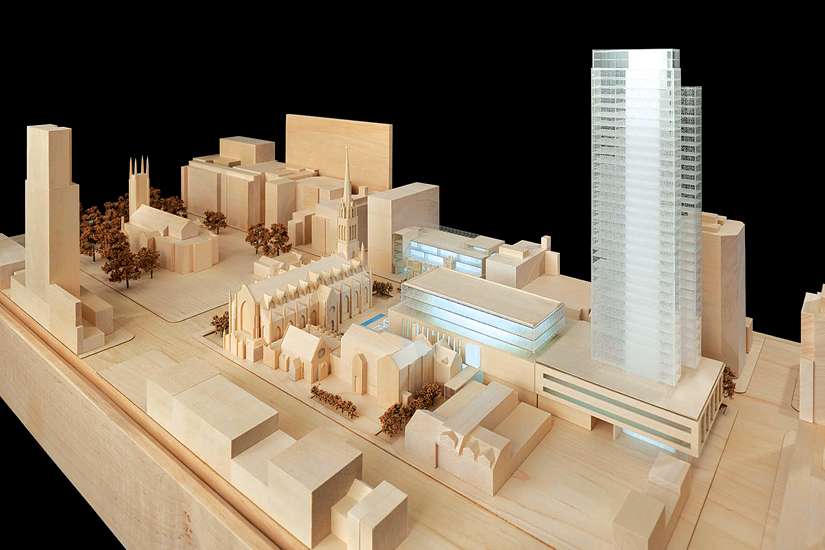Cathedral Square, an ambitious revitalization of the city block around the renovated St. Michael’s Cathedral, will not change the secular nature of Canada’s largest city. Rather, its purpose is to add a Catholic voice to the vast, secular diversity of cultures, faiths and languages that define Toronto.
When he introduced the concept in his 2013 pastoral plan for the archdiocese, Cardinal Thomas Collins spoke of Cathedral Square as a kind of Catholic answer to Dundas Square a short walk away. The pastoral plan called Cathedral Square “a place to highlight not only the search for truth and the exercise of practical charity, but also art and music, so as to reach out through beauty to the experience of God.”
With Ryerson University to the north, St. Michael’s Hospital to the south, the commerce of Yonge and Bay Streets to the west and some of the city’s poorest citizens to the east, Cathedral Square wants to be in the middle of the conversation about who we are — not just as individuals but as a city.
“This is a gift to Toronto,” said Cardinal Collins. “It’s our duty as well as our privilege to provide a sign of this vital Catholic community in the midst of the larger community of Toronto.”
A great hall, a gathering place for Catholics and for friends and neighbours of Catholics, will anchor the square as a venue for everything from sacred art and music to lectures, debates, dinners and hospitality. Inside will be a media centre to put Catholic web sites, publications and broadcasters on an even technological footing with Toronto’s dominant secular media. Outside, a garden will be open to the public as a respite from work days and shopping trips — an oasis beckoning tourists and neighbours. St. Michael’s Choir School will remain but undergo a total renovation.
For Cathedral Square architect Marianne McKenna, the square is also a defensive redoubt against the terrifying onslaught of condos and office towers which seek to occupy every square inch of open space in the city.
“Does everything have to be towers?” asks McKenna. “Can we not have different kinds of places in the city? I think we should ask.”
A founding partner of KPMB Architects, McKenna is the architect who designed Koerner Hall, the corporate offices of law firm Torys LLP, the Rotman School of Management at the University of Toronto and plenty more. She is a platinum-level member of Toronto’s establishment. But she has wearied of what boatloads of money have done for and to her city.
“Do we think our city is only towers? Is that what we are? Just warehousing people?” she asks. “Because of the smaller and smaller units, don’t people need a place to go to find spirituality in the cathedral or in the gardens — to find a place of contemplation or to find places of community?”
McKenna’s preliminary design for Cathedral Square and a new St. Michael’s Choir School has to make the most of a small but precious patch of land north of St. Michael’s Cathedral. Her proposal is the architectural opposite of the towers which have come to dominate the city. She has designed open, welcoming buildings to stand as neighbours to the restored cathedral.
And she loves the location.
“We are within a five-minute walk to Dundas Square – you know, the kind of Sodom and Gomorrah.”
Toronto Mayor John Tory has seen McKenna’s plans. The idea that architect-designed gardens might grace a neighbourhood that has struggled to become a more human place has him excited.
“Ms. McKenna, who is one of our most renowned Canadian architects, is looking at it in a broader sort of way,” said the mayor. “Can’t St. Michael’s Cathedral and shouldn’t St. Michael’s Cathedral become a place in a much broader sense, even for those who are not Catholic and don’t set foot inside the church, that they can come and rest and reflect and enjoy the outdoors in a city that is increasingly challenging for people to do that?”
 Architect Marianne McKenna. (Photo by Michael Swan)
Architect Marianne McKenna. (Photo by Michael Swan)
Tory imagines Cathedral Square as a place in the inner city for families. He won’t get an argument from Cardinal Collins. But the cardinal’s ambitions stretch further, to the evangelization of the city and the culture it represents.
The cardinal has often talked about the Church’s mission to “care for the gathered and reach out to the scattered.” Cathedral Square, twinned with a restored St. Michael’s Cathedral, provides an opportunity to see those words written into the heart of the city.
“People have profound illusions — illusions and delusions — about the Roman Catholic Church. That it is, for example, withering away. That it is somehow bureaucratic, or whatever. Not at all. That’s not the Church,” he said. “This is the vibrant sign to people, that for those who stroke their chins and nod their heads and think they’ve got the Catholic Church in a box, I say ‘Sorry.’ Tap, tap on the shoulder, ‘Look around. We’re much more than that. We’re not what you think we are. Come and see.’”
“Come and see” is not merely an invitation. It’s a quote from the first chapter of the Gospel of John.
“I think the words of Jesus, ‘Come and see,’ are still valid — very much so,” said Cardinal Collins. “Come and see. What you see is welcome, you see beauty, you see goodness and an outreach to the community which is remarkable.”
As a study continues to look at ways in which the square might be self-sustaining — generating enough income from commercial or institutional leaseholders but maintaining the special character of the development — many elements of the design remain tentative. But the project is ripe with possibilities.
“In a way, it’s sort of like a forgotten piece of the city,” said McKenna.
McKenna imagines Cathedral Square being a place in which Pope Francis would feel at home.
“Certainly the new Pope gives us all a better sense of what it is to be Roman Catholic,” she said. “You can imagine what that Pope would want to see — how to make it spiritual and accessible and engaging.”
In conversations with Cardinal Collins, McKenna heard him talk about truth, beauty and goodness as essential ingredients in the recipe for faith.
“Goodness and truth may be more important, but beauty is the doorway,” says the cardinal. Beauty can draw people, including people without faith, “to be touched by God.”
That’s the starting point for McKenna’s design. She is encouraged by the cardinal’s vision.
“Every project has a generating idea,” she said. “I think the cathedral and its architecture and the ability to have music play in there is that big idea we support (with Cathedral Square). We think about balancing the symbolic and spiritual with the practical and temporal… Beauty and a compelling narrative and the embodiment of the pastoral plan.”
When it comes to St. Michael’s Choir School, there’s an architectural imperative more basic than city beautification. The current school is falling down.
“They are living in totally Dickensian conditions,” McKenna said.
Her plan would maintain the historic front of the building, but add a modern school behind the facade. Across the street, instead of a parking lot, people will gather in a glass building above Bond Street to share a coffee after Mass or a dinner on great occasions — to hear a lecture or a concert, to look at paintings or photographs, to engage their curiosity. A small tower at the end of the square may become a home for seniors.
The architect’s deepest ambition is to give Cathedral Square a sense of place.
“An oasis, a place where you can walk right through the block, through the gardens here and that generally it would be open and not closed,” she said.
She imagines Pope Francis visiting Toronto. Bond Street would be closed to cars and he would walk towards St. Michael’s Cathedral, touching the crowds gathered in Cathedral Square.
“I think we do need to make it beautiful. It has to be a place of beauty,” McKenna said. “It’s about people coming together.”





























